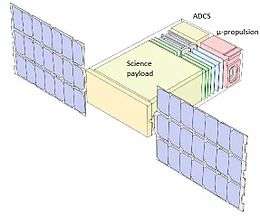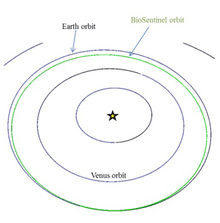BioSentinel
BioSentinel is a planned low-cost CubeSat spacecraft on a space biology mission that will use budding yeast to detect, measure, and compare the impact of deep space radiation on DNA repair over long time beyond low-Earth orbit.[1][4]
 | |
| Mission type | Space biology exposure and space medicine |
|---|---|
| Operator | NASA |
| Mission duration | 18 months (planned) |
| Spacecraft properties | |
| Spacecraft type | CubeSat |
| Bus | 6U |
| Manufacturer | NASA Ames Research Center |
| BOL mass | 14 kg (31 lb)[1] |
| Dimensions | 10×20×30 cm |
| Power | 30 W max (solar panels) |
| Start of mission | |
| Launch date | 2021[2][3] |
| Rocket | SLS |
| Launch site | Kennedy LC-39B |
| Orbital parameters | |
| Reference system | heliocentric |
| Transponders | |
| Band | X band |
Selected in 2013 for a 2020 launch, the spacecraft will operate in the deep space radiation environment throughout its 6-to-12-month mission.[5] This will help scientists understand the health threat from cosmic rays and deep space environment on living organisms and reduce the risk associated with long-term human exploration, as NASA plans to send humans farther into space than ever before.[4][5]
The mission is being developed by NASA Ames Research Center.
Background
BioSentinel is one of thirteen low-cost CubeSat missions selected as secondary payloads for Artemis 1 (formerly known as Exploration Mission 1), the first test flight of NASA's Space Launch System.[5][6] The spacecraft will be deployed in cis-lunar space. The BioSentinel mission will be NASA's first time since Apollo 17 in 1972, to send living organisms to deep space (beyond low Earth orbit).[6]
Objective
The primary objective of BioSentinel is to develop a biosensor using a simple model organism (yeast) to detect, measure, and correlate the impact of space radiation to living organisms over long durations beyond low Earth orbit (LEO) and into heliocentric orbit. While progress has been made with simulations, no terrestrial laboratory can duplicate the unique space radiation environment.[4][5]
Biological science
The BioSentinel biosensor uses the budding yeast Saccharomyces cerevisiae to detect and measure DNA damage response after exposure to the deep space radiation environment.[7] Two yeast strains were selected for this mission: a wild type strain proficient in DNA repair, and a strain defective in the repair of DNA double strand breaks (DSBs), deleterious lesions generated by ionizing radiation. Budding yeast was selected not only because of its flight heritage, but also because of its similarities with human cells, especially its DSB repair mechanisms.[1] The biosensor consists of specifically engineered yeast strains and growth medium containing a metabolic indicator dye. Therefore, culture growth and metabolic activity of yeast cells directly indicate successful repair of DNA damage.[1][5]
After completing the Moon flyby and spacecraft checkout, the science mission phase will begin with the wetting of the first set of yeast-containing wells with specialized media.[5] Multiple sets of wells will be activated at different time points over the 18-month mission. One reserve set of wells will be activated in the occurrence of a solar particle event (SPE). Approximately, a 4 to 5 krad total ionizing dose is anticipated.[1][8] Payload science data and spacecraft telemetry will be stored on board and then downloaded to the ground.[5]
Biological measurements will be compared to data provided by onboard radiation sensors and dosimeters. Additionally, three identical BioSentinel payloads will be developed for comparison reference, one of them will be exposed at low Earth orbit outside the International Space Station (ISS), where there is a comparatively low-radiation environment due to Earth's magnetic field protecting the space station.[1][5]
Spacecraft

The Biosentinel spacecraft will consist on a 6U CubeSat bus format, with external dimensions of approx. 10×20×30 cm and a mass of about 14 kg (31 lb).[1][4][5][9][10] At launch, BioSentinel resides within the second stage on the launch vehicle from which it is deployed to a lunar flyby trajectory and into an Earth-trailing heliocentric orbit.
Of the total 6 Units volume, 4 Units will hold the science payload, including a radiation dosimeter and a dedicated 3-color spectrometer for each well; 1U will house the ADCS (Attitude Determination and Control Subsystem) and 1U will house the attitude control thruster assembly, which will be 3D printed all in one piece: cold gas (DuPont R236fa) propellant tanks, lines and seven nozzles. The use of 3D printing also allows the optimization of space for increased propellant storage[11] (165 grams[7]). The thrust of each nozzle is 50 mN, and a specific impulse of 31 seconds.[11] The attitude control system is being developed and fabricated by the Georgia Institute of Technology.
Electric power will be generated by deployable solar panels rated at 30 W, and telecommunications will rely on the Iris transponder at X band.[1]
The spacecraft is being developed by NASA Ames Research Center, in collaboration with NASA Jet Propulsion Laboratory, NASA Johnson Space Center, NASA Marshall Space Flight Center, and NASA Headquarters.[1][4]
See also
- The 13 CubeSats flying on the Artemis 1
- Lunar Flashlight will map exposed water ice on the Moon
- Near-Earth Asteroid Scout by NASA is a solar sail spacecraft that will encounter a near-Earth asteroid
- BioSentinel is an astrobiology mission
- SkyFire by Lockheed Martin
- Lunar IceCube, by the Morehead State University
- CubeSat for Solar Particles (CuSP)
- Lunar Polar Hydrogen Mapper (LunaH-Map), designed by the Arizona State University
- OMOTENASHI, submitted by JAXA, is a lunar lander
- ArgoMoon, designed by Argotec and coordinated by Italian Space Agency
- Cislunar Explorers, Cornell University, Ithaca, New York
- Earth Escape Explorer (CU-E3), University of Colorado Boulder
- Team Miles, by Fluid & Reason, LLC. Florida
- Astrobiology missions
References
- Ricco, Tony (2014). "BioSentinel: DNA Damage-and-Repair Experiment Beyond Low Earth Orbit" (PDF). NASA Ames Research Center. Archived from the original (PDF) on 2015-05-25. Retrieved 2015-05-25.
- Clark, Stephen (28 April 2017). "NASA confirms first flight of Space Launch System will slip to 2019". Spaceflight Now. Retrieved 29 April 2017.
- "NASA's large SLS rocket unlikely to fly before at least late 2021". 17 July 2019.
- "NASA TechPort -- BioSentinel Project". NASA TechPort. National Aeronautics and Space Administration. Retrieved 19 November 2015.
- Caldwell, Sonja (5 August 2014). "Home Page of BioSentinel". NASA. Retrieved 2015-05-25.
- Clark, Stephen (8 April 2015). "NASA adding to list of CubeSats flying on first SLS mission". Spaceflight Now. Retrieved 2015-05-25.
- BioSentinel: Mission Development of a Radiation Biosensor to Gauge DNA Damage and Repair Beyond Low Earth Orbit on a 6U NanosatelliteHugo (PDF). Hugo Sanchez, NASA. 20 April 2016.
- BioSentinel Presentation Archived May 26, 2015, at the Wayback Machine 2014 (PDF)
- Krebs, Gunter Dirk (2015). "BioSentinel". Gunter's Space Page. Retrieved 2015-05-25.
- Krebs, Gunter Dirk (13 April 2015). "NEA-Scout". Retrieved 2015-05-13.
- Design and characterization of a 3D-printed attitude control thruster for an interplanetary 6U CubeSat (PDF). Terry Stevenson, et al. Georgia Institute of Technology. 2017.
External links
- Fact Sheet of BioSentinel, at NASA (PDF)